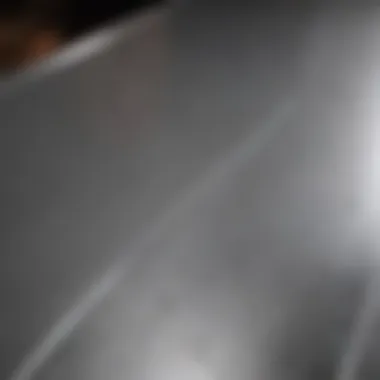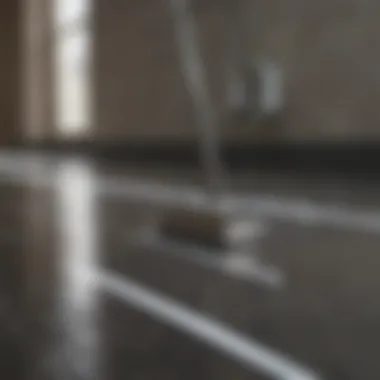Comprehensive Guide to Cleaning Brushed Stainless Steel


Intro
Brushed stainless steel is a popular material in modern homes and commercial spaces. Its distinct finish provides an elegant appearance while also being durable and resistant to rust and corrosion. Many people appreciate its aesthetic value, yet maintaining its beauty requires understanding the right cleaning methods. This guide will delve into effective cleaning techniques for brushed stainless steel, ensuring surfaces remain pristine.
The significance of proper cleaning techniques cannot be overstated. Using incorrect products or methods can lead to unsightly scratches or dullness. By following the right procedures and employing suitable tools, you can preserve the finish and prolong the lifespan of your brushed stainless steel surfaces.
In this article, we will cover:
- The unique characteristics of brushed stainless steel.
- Common cleaning agents and tools.
- Step-by-step cleaning procedures.
- Mistakes to avoid when cleaning.
Through these insights, you will learn how to care for brushed stainless steel effectively, keeping its aesthetic appeal intact. Homeowners and design enthusiasts alike will benefit from practical advice tailored to their needs.
Understanding Brushed Stainless Steel
Brushed stainless steel is not just a material choice; it reflects a certain aesthetic and functionality in various applications. Understanding it helps individuals in their selections, whether for kitchen design, appliance procurement, or architectural details. This section delves into the specifics of this material, allowing readers to grasp its unique characteristics and benefits.
Defining Brushed Stainless Steel
Brushed stainless steel is a type of steel that has been treated to create a distinct texture. Unlike polished stainless steel, which has a shiny surface, brushed stainless steel features a non-reflective, matte finish. This effect is achieved by polishing the steel with a fine-bristled brush or abrasive pads. This treatment does not only enhance its visual appeal but also improves its durability and resistance to scratches and fingerprints.
The composition of brushed stainless steel typically includes nickel and chromium, giving it excellent corrosion resistance while providing it with a robust structure. Common grades, like 304 and 316, are favored for their performance in protecting against rust and wear. This material’s defined line patterns make it a preferred choice in contemporary design, contributing to sleek and minimalist aesthetics.
Common Applications of Brushed Stainless Steel
The versatile nature of brushed stainless steel allows it to be utilized across a myriad of applications. Here are some of the most common:
- Kitchen Appliances: Many homeowners choose brushed stainless steel for refrigerators, stoves, and dishwashers due to its modern look and resistance to dirt.
- Countertops: It provides a durable and easy-to-clean surface that handles high temperatures well.
- Architectural Elements: Railings, door handles, and outdoor fixtures often feature this material, offering both style and strength.
- Commercial Use: In hospitals and food service environments, brushed stainless steel is used for its sanitation properties and ease of maintenance.
By understanding the features and common uses of brushed stainless steel, readers can make informed decisions about integrating this material into their environments, ensuring both aesthetic appeal and longevity.
The Importance of Proper Maintenance
Maintaining brushed stainless steel is crucial to preserving its aesthetic appeal and functionality. This material is widely appreciated for its sleek appearance and durability, but it requires specific care to retain these qualities. Proper maintenance prevents tarnishing, scratches, and other forms of damage that can arise from neglect. A consistent cleaning routine not only enhances visual appeal but also extends the lifespan of the stainless steel. Investing time in maintenance is, therefore, a wise choice for both homeowners and design enthusiasts alike.
Why Cleaning Matters
Cleaning brushed stainless steel is not just about appearance; it is a matter of protection. Over time, dirt, grease, and fingerprints can accumulate on the surface, leading to an unkempt look. Regular cleaning helps to eliminate these unwanted substances before they cause permanent stains.
Additionally, cleaning plays a role in hygiene, especially in environments like kitchens or medical facilities. The surfaces benefit from being free of contaminants, which could potentially affect the health of individuals in those spaces.
The process of cleaning allows for the inspection of the surface, enabling identification of any scratches or blemishes that may need further attention. By staying proactive, the integrity of brushed stainless steel lasts longer.
The Consequences of Neglecting Care
Neglecting the maintenance of brushed stainless steel can lead to significant consequences. The most immediate effect is the visible dulling of surfaces. Over time, without proper cleaning, stains can become embedded, making removal much more difficult. Eventually, this neglect can turn brushed stainless steel into a surface that appears aged and unattractive.
Moreover, contaminants can lead to corrosion. Stainless steel is known for its resistance to rust, but it is not immune. Substances like salt and chlorides can accelerate this process, especially in coastal areas or places exposed to harsh chemicals.
In terms of cost, allowing brushed stainless steel to fall into disrepair can result in pricey replacements or refinishing. It is far more economical to maintain than to replace.


In summary, understanding the importance of proper maintenance is essential to ensuring both the beauty and longevity of brushed stainless steel. The benefits of regular cleaning far outweigh the potential pitfalls of neglect.
Essential Cleaning Supplies
When it comes to cleaning brushed stainless steel, using the right supplies is crucial. Without the proper tools and agents, the cleaning process might not only be ineffective but could also lead to damage. This section covers the essential supplies needed, their benefits, and some important considerations.
Recommended Cleaning Agents
Choosing the right cleaning agents is vital for maintaining the integrity of brushed stainless steel. Here are some recommended cleaning agents:
- Mild Dish Soap: A simple solution mixed with warm water can effectively lift dirt and grime from the surface. It’s important to ensure that the soap is free of strong chemicals that could harm the finish.
- White Vinegar: This is an effective natural cleaner. It not only cleans but also helps to remove fingerprints and smudges. The vinegar should be diluted with equal parts water for the best results.
- Glass Cleaner: A non-ammonia-based glass cleaner can serve dual purposes by cleaning stainless steel and leaving a streak-free shine.
- Specialized Stainless Steel Cleaners: Products like Weiman's Stainless Steel Cleaner are designed specifically for stainless steel surfaces. They can enhance shine and create a protective layer that repels dirt and fingerprints.
Tools Required for Effective Cleaning
Having the right tools can make the cleaning process more efficient. Here are some essential tools that should be in every cleaning kit for brushed stainless steel:
- Microfiber Cloths: These cloths are non-abrasive and ideal for wiping down surfaces without scratching. Their softness helps to prevent damage while effectively trapping dust and dirt.
- Soft-Bristled Brush: For any textured areas, a soft-bristled brush can be useful. It allows you to clean without scratching the surface.
- Bucket: A clean bucket is necessary for mixing solutions and rinsing cloths.
- Sponge or Soft Scrub Pad: These can help with stubborn spots but should be used cautiously to avoid scratches.
- Spray Bottles: Using spray bottles for your cleaning solutions allows for even application and reduces waste.
By ensuring you have the right cleaning agents and tools, you set yourself up for success in maintaining the appearance and longevity of your brushed stainless steel surfaces.
Step-by-Step Cleaning Guide
This section is crucial for ensuring the proper maintenance of brushed stainless steel surfaces. A step-by-step cleaning guide provides a clear methodology, helping users achieve consistent results without damaging the material. Understanding and implementing this structured approach can substantially prolong the material's aesthetic appeal and functional longevity. Each step focuses on specific actions that need to be taken, highlighting not only the procedural aspects but also the importance of careful techniques and the right tools.
Preparing the Cleaning Area
Preparing the cleaning area is a foundational step that sets the tone for the entire cleaning process. An organized and accessible space will enhance efficiency and safety while reducing the risk of accidents.
- Clear the Surface: Remove any items on the stainless steel surface that may hinder cleaning. This includes appliances, utensils, or decor.
- Safety Gear: Consider wearing gloves to protect your skin from cleaning solutions, which can be harsh.
- Dust Removal: Utilize a soft cloth or microfiber cloth to wipe away loose dust and debris. This initial cleaning prevents scratching during deeper cleaning.
By establishing a clean environment, the user can prevent additional dirt from transferring back onto the surface during cleaning.
Applying the Cleaning Solution
This step focuses on the effective application of the chosen cleaning solution. Applying the cleaning solution properly ensures that it adheres to the stainless steel and can penetrate any grime effectively.
- Selecting the Right Product: Ensure that the cleaning solution is formulated for stainless steel. Avoid using products that contain bleach or ammonia, as these can cause discoloration.
- Application Method: Using a clean cloth, apply the solution directly to the cloth rather than applying it directly onto the surface. This method allows for better control and minimizes the risk of overspray.
- Gentle Motion: Begin to wipe the surface with the cloth in a straight line grain direction of the brushed finish. Avoid circular motions, as they may create scratches.
Following these steps ensures an even coverage of the cleaning agent, which is essential for effective stain removal.
Wiping and Polishing Techniques
Correct wiping and polishing techniques are vital as they contribute not only to cleanliness but also to the desired shine. A well-polished finish significantly enhances the visual appeal of brushed stainless steel.
- Using the Right Cloth: Opt for a microfiber cloth. These cloths are designed to lift and trap dirt while minimizing the risk of scratches.
- Technique: After applying the cleaning solution, wipe the surface in the direction of the grain. This technique helps to lift the grime effectively without damaging the brushed finish.
- Polishing: Once the surface is clean, a second dry microfiber cloth can be used for polishing. This further enhances the sheen without leaving streaks.
Proper wiping and polishing preserve the texture of brushed stainless steel, maintaining its elegance and preventing premature wear.
Final Touches and Inspection


The last stage in the cleaning process is essential for confirming the quality of the work performed. This ensures that every part of the surface is adequately cleaned and that any remaining areas are addressed.
- Detailed Inspection: After cleaning, examine the surface under good lighting to identify any spots or areas that may have been missed. Pay special attention to corners and crevices where dirt may accumulate.
- Reapplication if Necessary: If any stains persist, it may be necessary to reapply the cleaning solution to those specific areas, following the previous steps.
- Final Polish: Ensure the surface is dry and apply a light polish using a clean, dry microfiber cloth to restore the surface's luster.
Incorporating these final touches reinforces the quality of maintenance, enhancing the overall appearance and durability of brushed stainless steel surfaces.
Handling Tough Stains and Marks
Cleaning brushed stainless steel is not merely about maintenance; it involves persistence in addressing tough stains and marks. Properly managing these blemishes is essential to retain the aesthetic appeal and essence of the material. Tough stains detract from its shine and, if overlooked, can lead to corrosion over time. This section will discuss identifying common stains and specialized techniques to address difficult marks effectively.
Identifying Common Stains
Brushed stainless steel is often exposed to several potential staining agents, which can range from food residues to environmental factors. Common stains include:
- Water spots: These often appear after exposure to moisture and minerals in water. They leave behind dull marks that mar the finish.
- Fingerprints: Oils and dirt from hands leave visible marks, particularly in high-touch areas like kitchen appliances.
- Food stains: Ingredients like tomato sauce, mustard, or cooking oils can leave lingering discolourations.
- Rust marks: If items made of iron come into contact with brushed stainless steel, they can leave behind rust transfer marks, which are challenging to remove.
Identifying these stains promptly is crucial. The sooner they are addressed, the easier they are to clean and the less likely they are to cause permanent damage.
Specialized Techniques for Difficult Stains
When standard cleaning methods fail to tackle tough stains, specialized techniques may be necessary. Here are some effective strategies to consider:
- Baking soda paste: Mix baking soda with a little water to form a paste. Apply this gently to stained areas and let it sit for several minutes. The mildly abrasive nature of baking soda can help lift stubborn stains without scratching the metal.
- White vinegar solution: Mix equal parts of white vinegar and water in a spray bottle. Spray the solution on the stain and let it sit for a few minutes before wiping it away. This method works well on water stains and light rust.
- Commercial stainless steel cleaners: There are specific products designed for tough stains. When choosing one, opt for a cleaner made specifically for brushed stainless steel. Always follow the product's instructions carefully to avoid damage.
- Fine steel wool: For extremely difficult rust stains, fine-grade steel wool can be employed with caution. Always test a small inconspicuous area first to ensure that it does not scratch the surface.
"Understanding the nature of specific stains is key when determining the best cleaning approach. A methodical response ensures not just the removal of stains but also the preservation of the material's integrity."
Common Mistakes to Avoid
Cleaning brushed stainless steel requires careful consideration. Mistakes in the process can lead to damage or dullness that detracts from its aesthetic appeal. Understanding what not to do is just as crucial as knowing the right methods and materials. Learning about common pitfalls can save time, effort, and even money in the long run. This section highlights two critical areas where mistakes are often made, focusing on the use of incorrect cleaning products and improper techniques.
Incorrect Cleaning Products
Using the wrong cleaning solutions can compromise the finish of brushed stainless steel. Certain components found in many common household cleaners, like bleach or ammonia, can be too harsh. They can create discoloration or even corrosion over time. Moreover, scouring pads or steel wool, though tempting for stubborn stains, can scratch the surface, resulting in permanent marks.
The following are some products to avoid:
- Bleach: It can cause rust and dullness in the metal.
- Ammonia-based cleaners: These may lead to tarnish and haziness.
- Scouring pads: Often causes fine scratches on the finish.
- Oil-based cleaners: They can leave a residue that attracts dirt.
Instead, opt for mild soaps or dedicated stainless steel cleaners that are formulated to safely maintain the surface without causing harm. Choosing appropriate products ensures the longevity of your brushed stainless steel's appearance.
Improper Techniques That Cause Damage
How one cleans brushed stainless steel is as important as what is used. Incorrect techniques do not merely hinder the cleaning process; they risk damaging the surface. One common mistake is scrubbing vigorously, thinking it will remove dirt faster. Aggressive scrubbing can result in fine scratches, which mar the matte finish that makes brushed stainless steel visually appealing.
Additionally, cleaning in the wrong direction can be problematic. Brushed stainless steel has a directional finish, meaning it is designed to be cleaned along the grain. Wiping against the grain may create a streaked appearance that detracts from the overall look. For best results, use soft cloths and follow these guidelines:
- Do not scrub hard: Use gentle pressure with a soft cloth.
- Follow the grain: Wipe in the direction of the brush marks.
- Avoid circular motions: This can create a inconsistent shine.
"Proper technique not only preserves the appearance but also enhances durability."


Maintaining Brushed Stainless Steel Over Time
Maintaining brushed stainless steel over time is essential to sustain its aesthetic appeal and functional integrity. Regular care helps prevent discoloration, tarnishing, or other visible damage that could affect its appearance. The inherent properties of brushed stainless steel make it durable yet susceptible to environmental factors such as humidity, temperature fluctuations, and exposure to various substances. Thus, a solid maintenance plan is crucial for ensuring longevity.
Establishing a Regular Cleaning Routine
A regular cleaning routine is vital for preserving the beauty of brushed stainless steel surfaces. This not only minimizes the accumulation of dirt and fingerprints but also enhances the material's overall lifespan. Here are a few points to consider:
- Frequency: Ideally, surfaces should be cleaned weekly to maintain their shine and prevent buildup, especially in high-traffic areas like kitchens.
- Method: Use a soft cloth or microfiber towel to avoid scratching the surface. Pair this with a gentle cleaning solution appropriate for stainless steel.
- Prevention: Encourage a habit of wiping down surfaces after use, especially for appliances exposed to food or liquid splatters.
Incorporating these steps into a routine can significantly reduce the time spent on more intensive cleaning sessions, promoting an effortless maintenance approach.
Long-Term Care Strategies
For long-term care of brushed stainless steel, several strategies can contribute to maintaining its appearance and function over the years:
- Avoid Harsh Cleaners: Steer clear of abrasive pads and cleaners that can scratch or dull the finish. Instead, opt for products specifically designed for stainless steel.
- Use Protective Coatings: Consider applying a stainless steel cleaner with protective properties. This not only cleans but also forms a barrier against smudging and fingerprints.
- Correct Installation: Ensure that all installations allow for proper airflow and drainage. This can prevent moisture accumulation and overheating, which may lead to corrosion.
- Monitor Humidity Levels: In areas with high humidity, proactively use dehumidifiers to reduce moisture, safeguarding against rust development on your stainless steel.
- Periodically Inspect: Regular inspections can help detect any early signs of corrosion or marks that require immediate attention.
Regular care can enhance the lifespan of your brushed stainless steel surfaces. By enforcing a simple yet effective maintenance routine, you can elevate the aesthetic and practical value of your fixtures.
Environmental Considerations in Cleaning
Cleaning brushed stainless steel not only involves maintaining its visual appeal but also requires a keen awareness of environmental considerations. The impact of cleaning products and methods on the environment can no longer be overlooked. It's essential to take into account the ingredients in cleaning agents, their effects on ecosystems, and the residues left behind after cleaning. Reflecting on these factors is crucial for sustainable home maintenance and aligns with the global movement towards greener living practices.
Using eco-friendly cleaning products can significantly reduce your carbon footprint. They are usually made from natural ingredients that are less harmful to the environment compared to conventional cleaners, which often contain harsh chemicals. Moreover, cleaning responsibly promotes the health of indoor environments and minimizes exposure to potentially toxic substances.
Choosing Eco-Friendly Products
When selecting cleaning products for brushed stainless steel, opt for eco-friendly alternatives. Look for products labeled as “biodegradable” or “non-toxic.” These items typically break down naturally without leaving harmful residues. The use of plant-based surfactants and natural oils not only effectively cleans surfaces but also aligns with sustainable practices.
Here are some eco-friendly options:
- Vinegar: This natural cleaner is effective at removing stains and fingerprints from stainless steel.
- Baking Soda: Gentle yet effective, it can act as a scrub to eliminate tough marks without scratching the surface.
- Olive Oil: A small amount can be applied to polish and protect the finish after cleaning.
By choosing these alternatives, you can maintain the cleaning effectiveness while safeguarding the environment.
Reducing Chemical Residues
Another vital aspect of environmentally conscious cleaning is being mindful of chemical residues left behind after cleaning. Traditional cleaning agents can often leave a lasting residue that not only affects the surface but also can pose health risks. Choosing products that are designed to rinse clean can help alleviate this issue.
To further reduce residues, consider the following steps:
- Rinse Thoroughly: After using a cleaning solution, ensure that you wipe the surface down with a damp cloth to remove any leftover chemicals.
- Use Minimal Product: More is not always better. Using just enough cleaner to effectively do the job reduces waste and potential residues.
- Opt for Non-Residue Formulations: Some products are specifically formulated to rinse away without leaving harmful residues, offering peace of mind for sensitive environments.
Ultimately, understanding and implementing these environmental considerations leads to not just a cleaner home but also a healthier planet.
End
Cleaning brushed stainless steel surfaces is essential for preserving their aesthetic appeal and functional integrity. As discussed throughout this guide, proper maintenance not only enhances the visual aspect but also ensures longevity. Regularly cleaning these surfaces prevents buildup that can lead to damage over time. Moreover, using the right techniques and products mitigates the risk of scratches or tarnishing, which can detract from the overall look.
Summary of Key Practices
- Establish a Routine: Make cleaning a regular part of your home maintenance schedule. A consistent approach helps to keep nons handprints and smudges at bay.
- Use Appropriate Products: Select cleaning agents formulated specifically for brushed stainless steel. Avoid abrasive materials that can scratch the surface.
- Gentle Techniques: Opt for soft cloths or sponges when cleaning. Always wipe in the direction of the grain to maintain the finish.
- Inspect Regularly: After cleaning, take the time to examine the surface for any signs of stains or scratches that may require attention.
- Eco-Conscious Choices: Consider environmentally-friendly products, which are not only safer for your health but also reduce chemical impact on your surroundings.
Adhering to these practices ensures that your brushed stainless steel items retain their sophistication and functionality for many years to come. By being mindful of how you care for these surfaces, you enhance both their beauty and utility.







